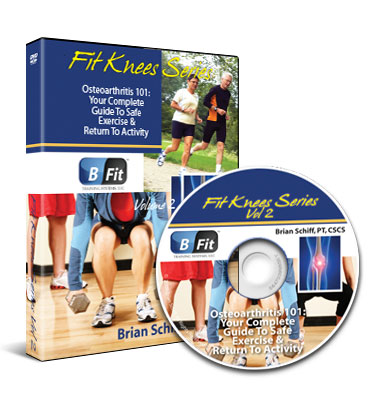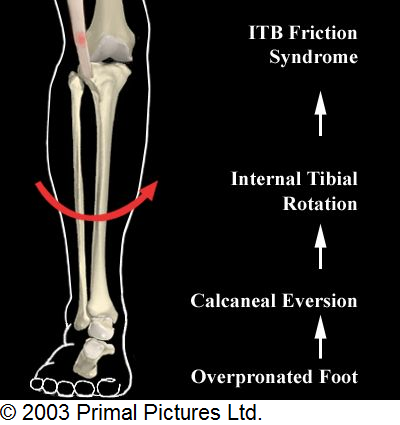Brian Schiff’s Blog
Injury Prevention, Sports Rehab & Performance Training Expert
If you know anyone with chronic or acute knee pain related to arthritis, then you know how frustrating and depressing it can be to live day to day, let alone exercise. Arthritis comes in all forms and attacks all ages. I have seen traumatic arthritis ruin professional sports careers, as well as chronic progressive OA make getting out of bed a major obstacle for people.
So, today, I am unveiling two very simple exercises anyone can do at home. These are 100% safe and will not cause any harm to the knee joint. They will allow one to begin inflammation reduction strengthening safely. You see, rest, pills and activity modification goes only so far.
Most people want to live. Whether that is daily function or playing tennis, they will settle for nothing less. That is where the right exercise program comes into play. I am giving you a glimpse into my new DVD program titled Osteoarthritis 101: Your Complete Guide to Safe Exercise and Return to Activity. It will be officially released in the next 2 weeks or so, but you can grab a copy at a significant discount in the meantime (first 100 pre-sales on my site).
In today’s video, I reveal exercise from Phase I (Infammation Reduction) of my specific 6 phase exercise system. Please pass this post along to anyone suffering from arthritis or tweet it.

Fit Kness Series - Osteoarthritis 101
As I continue on with my arthritis series, I am going to talk about a very common problem in women. It is patello-femoral arthritis, also commonly referred to as anterior knee pain, chondromalacia, and patello-femoral pain syndrome.
So what is it exactly? Well, it simply means degeneration of the cartilage lining the back of the kneecap. Take a peek at the facets on the back of your kneecap below.

Typically, people with PFP experience pain along the lateral facet as it glides and tracks on the femur. Women see this more so as they tend to have a more laterally tilted or laterally tracking patella. As such, this is why I am against using the knee extension machine as it grinds the facet as you extend the knee. In addition to shear forces, direct compressive force by way of prolonged kneeling, falls, and repetitive impact may damage any part of the facets.
Signs and symptoms of patello-femoral pain may include:
- Pain in the center of the knee or behind the kneecap
- Pain which may radiate along the inside or outisde of the knee
- Pain with kneeling, stooping, stair descension, squatting, jumping and running
- Pain or stiffness with prolonged sitting (desk, car or plane)
- Grinding or “rice krispie” sounds with movement
I included another picture below demonstrating Grade IV chondromalacia (the worst degree).

In the next post, I will give you a few simple exercises to safely strengthen the knee in clients who may be suffering from this type of arthritis.
Today, I am including a picture to better reveal the physical effects of pronation on the knee joint.

Now, in this photo of the right knee it points out ITB friction syndrome (runner’s knee). You can see how force is transmitted up the kinetic chain based on bio mechanical alignment. With increased internal tibial rotation, ITB irritation is a distinct possibility. In addition, it is important to note that this pronation also leads to increased valgus moments (knee caves inward) leading to added stress to the knee. It may also create increase shear force along the lateral patella and compressive force along the lateral knee joint.
This abnormal force transmission is one of the primary reasons runners with overpronation experience ITB and lateral knee pain. Aside from utilizing arch supports, getting proper footwear and gradually increasing mileage, there are some essential strengthening and stretching exercises to include if you have overpronation issues including:
- ITB stretching
- Hamstring and calf stretching
- Quadriceps strengthening
- Gluteus medius strengthening
- Single leg (knee bent) balance and reaching
- Single leg calf raises to increase arch support by strengthening the posterior tibialis
In the next post, I will review Chondromalacia (softening of the cartilage behind the kneecap) and patello-femoral arthritis, a condition that affects many women over the age of 30. I also wanted to let you know I will be releasing a DVD on knee arthritis in the next few weeks. If you read my blog, you will be entitled to a special pre-release offer as well. Stay tuned for more details.
Today, I begin a series on knee arthritis. Whether you simply want to do simple day to day things like get up out of a chair and walk up/down stairs or return to recreational sports without pain, you need tofirst understand how force (your own body weight) affects your knee. Over the next several posts, I will dive into this topic as I prepare to launch a new exercise DVD in my Fit Knees Series aimed at diminishing arthritic pain.

Severe Pronation
This is the last part of my ACL series (for now anyway). Today, I want to share a simple drill for teaching athletes to decelerate properly when moving side to side. So many kids lack the ability to slow momentum correctly at high speeds. Rather than stay low, they often tend to remain upright.
This posture not only reduces power and quickness, but it also increases injury risk. You see, it is darn near impossible to tear your ACL when the knee is flexed near 90 degrees. The knee is more at risk when the flexion angle is closer to 30 degrees (in general) when examining non-contact injuries. Teaching athletes to stay low will improve force generation, change of direction speed and reduce injuries.
So, in today’s video I will show you how to do just that. Keep in mind this drill can be done for quickness (shorter strides), power (longer strides) or just form work (shown here).
If you enjoyed these videos and want more information on my exact training program to prevent ACL injuries, you can pre order my DVD now. It will normally retail for $34.95, but if you pre order now, you can get it for just $19.95. I will throw in free shipping anywhere in the US too.

To order, simply go to www.BrianSchiff.com.




